Enhancing CO2 Hydrogenation to Methane by Ni-Based Catalyst with V Species Using 3D-mesoporous KIT-6 as Support
Abstract
:1. Introduction
2. Materials and Methods
2.1. Catalyst Preparation
2.2. Catalyst Characterization
2.3. Catalytic Performance Measurement
3. Results
3.1. Characterization
3.2. Effect of V2O5 and NiO Loading
3.3. Stability Test of 20Ni-0.5V/KIT-6
4. Conclusions
Author Contributions
Funding
Conflicts of Interest
References
- Zhang, F.F.; Guo, L.H.; Ding, Y.D.; Zhu, X.; Liao, Q. Flow pattern and CO2 absorption in a falling film reactor with mixed aqueous solution of ionic liquid and MEA. Appl. Therm. Eng. 2018, 138, 583–590. [Google Scholar] [CrossRef]
- Guo, C.; Duan, D.; Sun, Y.; Han, Y.; Zhao, S. Enhancing Scenedesmus obliquus biofilm growth and CO2 fixation in a gas-permeable membrane photobioreactor integrated with additional rough surface. Algal Res. 2019, 43, 101620. [Google Scholar] [CrossRef]
- Zhang, Z.E.; Cai, J.C.; Chen, F.; Li, H.; Zhang, W.X.; Qi, W.J. Progress in enhancement of CO2 absorption by nanofluids: A mini review of mechanisms and current status. Renew. Energy 2018, 118, 527–535. [Google Scholar] [CrossRef]
- Li, H.; Zhang, Z.E. Mining the intrinsic trends of CO2 solubility in blended solutions. J. CO2 Util. 2018, 26, 496–502. [Google Scholar] [CrossRef]
- Li, K.Z.; Chen, J.G. CO2 Hydrogenation to methanol over ZrO2-containing catalysts: Insights into ZrO2 induced synergy. ACS Catal. 2019, 9, 7840–7861. [Google Scholar] [CrossRef]
- Guo, C.L.; Wang, W.; Duan, D.R.; Zhao, C.Y.; Guo, F.Q. Enhanced CO2 biofixation and protein production by microalgae biofilm attached on modified surface of nickel foam. Bioproc. Biosyst. Eng. 2019, 42, 521–528. [Google Scholar] [CrossRef] [PubMed]
- Wang, Y.H.; Kattel, S.; Gao, W.G.; Li, K.Z.; Liu, P.; Chen, J.G.; Wang, H. Exploring the ternary interactions in Cu-ZnO-ZrO2 catalysts for efficient CO2 hydrogenation to methanol. Nat. Commun. 2019, 10, 1–10. [Google Scholar] [CrossRef]
- Li, L.; Tang, D.W.; Song, Y.C.; Jiang, B.; Zhang, Q. Hydrogen production from ethanol steam reforming on Ni-Ce/MMT catalysts. Energy 2018, 149, 937–943. [Google Scholar] [CrossRef]
- Riani, P.; Garbarino, G.; Cavattoni, T.; Canepa, F.; Busca, G. Unsupported cobalt nanoparticles as catalysts: Effect of preparation method on catalytic activity in CO2 methanation and ethanol steam reforming. Int. J. Hydrogen Energy 2019, 44, 27319–27328. [Google Scholar] [CrossRef]
- Li, W.H.; Ni, X.W.; Jiang, X.; Zhang, A.F.; Ding, F.S.; Liu, M.; Liu, Z.M.; Guo, X.W.; Song, C.S. ZrO2 support imparts superior activity and stability of Co catalysts for CO2 methanation. Appl. Catal. B Environ. 2018, 220, 397–408. [Google Scholar] [CrossRef]
- Bailera, M.; Lisbona, P.; Romeo, L.M.; Espatolero, S. Power to gas projects review: Lab, pilot and demo plants for storing renewable energy and CO2. Renew. Sustain. Energy Rev. 2017, 69, 292–312. [Google Scholar] [CrossRef]
- Aziz, M.A.A.; Jalil, A.A.; Triwahyono, S.; Ahmad, A. CO2 methanation over heterogeneous catalysts: Recent progress and future prospects. Green Chem. 2015, 17, 2647–2663. [Google Scholar] [CrossRef]
- Arellano-Trevino, M.A.; Kanani, N.; Jeong-Potter, C.W.; Farrauto, R.J. Bimetallic catalysts for CO2 capture and hydrogenation at simulated flue gas conditions. Chem. Eng. J. 2019, 375, 121953. [Google Scholar] [CrossRef]
- Su, X.; Xu, J.H.; Liang, B.L.; Duan, H.M.; Hou, B.L.; Huang, Y.Q. Catalytic carbon dioxide hydrogenation to methane: A review of recent studies. J. Nat. Gas Chem. 2016, 25, 553–565. [Google Scholar] [CrossRef]
- Petala, A.; Panagiotopoulou, P. Methanation of CO2 over alkali-promoted Ru/TiO2 catalysts: I. Effect of alkali additives on catalytic activity and selectivity. Appl. Catal. B Environ. 2018, 224, 919–927. [Google Scholar] [CrossRef]
- Guo, Y.; Mei, S.; Yuan, K.; Wang, D.J.; Liu, H.C.; Yan, C.H.; Zhang, Y.W. Low-temperature CO2 methanation over CeO2-supported Ru single atoms, nanoclusters, and nanoparticles competitively tuned by strong metal-support interactions and H-spillover effect. ACS Catal. 2018, 8, 6203–6215. [Google Scholar] [CrossRef]
- Liu, Q.; Wang, S.J.; Zhao, G.M.; Yang, H.Y.; Yuan, M.; An, X.X.; Zhou, H.F.; Qiao, Y.Y. CO2 methanation over ordered mesoporous NiRu-doped CaO-Al2O3 nanocomposites with enhanced catalytic performance. Int. J. Hydrogen Energy 2018, 43, 239–250. [Google Scholar] [CrossRef]
- Arandiyan, H.; Wang, Y.; Scott, J.; Mesgari, S.; Dai, H.X.; Amal, R. In situ exsolution of bimetallic Rh−Ni nanoalloys: A highly efficient catalyst for CO2 methanation. ACS Appl. Mater. Int. 2018, 10, 16352–16357. [Google Scholar] [CrossRef]
- Jacquemin, M.; Beuls, A.; Ruiz, P. Catalytic production of methane from CO2 and H2 at low temperature: Insight on the reaction mechanism. Catal. Today 2010, 157, 462–466. [Google Scholar] [CrossRef]
- Arellano-Trevino, M.A.; He, Z.Y.; Libby, M.C.; Farrauto, R.J. Catalysts and adsorbents for CO2 capture and conversion with dual function materials: Limitations of Ni-containing DFMs for flue gas applications. J. CO2 Util. 2019, 31, 143–1451. [Google Scholar] [CrossRef]
- Le, T.A.; Kim, M.S.; Lee, S.H.; Kim, T.W.; Park, E.D. CO and CO2 methanation over supported Ni catalysts. Catal. Today 2017, 293–294, 89–96. [Google Scholar] [CrossRef]
- Ratchahat, S.; Sudoh, M.; Suzuki, Y.; Kawasaki, W.; Watanabe, R.; Fukuhara, C. Development of a powerful CO2 methanation process using a structured Ni/CeO2 catalyst. J. CO2 Util. 2018, 24, 210–219. [Google Scholar] [CrossRef]
- Guo, X.P.; Peng, Z.J.; Hu, M.X.; Zuo, C.C.; Traitangwong, A.; Meeyoo, V.; Li, C.S.; Zhang, S.J. Highly active Ni-based catalyst derived from double hydroxides precursor for low temperature CO2 methanation. Ind. Eng. Chem. Res. 2018, 57, 9102–9111. [Google Scholar] [CrossRef]
- Bacarizaa, M.C.; Malevalb, M.; Graçac, I.; Lopesa, J.M.; Henriquesa, C. Power-to-methane over Ni/zeolites: Influence of the framework type. Microporous Mesoporous Mat. 2019, 274, 102–112. [Google Scholar] [CrossRef]
- Le, T.A.; Kang, J.K.; Park, E.D. CO and CO2 methanation over Ni/SiC and Ni/SiO2 catalysts. Top. Catal. 2018, 61, 1537–1544. [Google Scholar] [CrossRef]
- Song, F.J.; Zhong, Q.; Yu, Y.; Shi, M.G.; Wu, Y.H.; Hu, J.H.; Song, Y. Obtaining well-dispersed Ni/Al2O3 catalyst for CO2 methanation with a microwave-assisted method. Int. J. Hydrogen Energy 2017, 42, 4174–4183. [Google Scholar] [CrossRef]
- Aziz, M.A.A.; Jalil, A.A.; Triwahyono, S.; Mukti, R.R.; Taufiq-Yap, Y.H.; Sazegar, M.R. Highly active Ni-promoted mesostructured silica nanoparticles for CO2 methanation. Appl. Catal. B Environ. 2014, 147, 359–368. [Google Scholar] [CrossRef]
- Bacariza, M.C.; Graça, I.; Bebiano, S.S.; Lopes, J.M.; Henriques, C. Micro- and mesoporous supports for CO2 methanation catalysts: A comparison between SBA-15, MCM-41 and USY zeolite. Chem. Eng. Sci. 2018, 175, 72–83. [Google Scholar] [CrossRef] [Green Version]
- Lu, B.W.; Ju, Y.W.; Abea, T.; Kawamoto, K. Grafting Ni particles onto SBA-15, and their enhanced performance for CO2 methanation. RSC Adv. 2015, 5, 56444–56454. [Google Scholar] [CrossRef]
- Budi, C.S.; Wu, H.C.; Chen, C.S.; Saikia, D.; Kao, H.M. Ni nanoparticles supported on cage-type mesoporous silica for CO2 hydrogenation with high CH4 selectivity. Chemsuschem 2016, 9, 2326–2331. [Google Scholar] [CrossRef]
- Lu, X.P.; Gu, F.N.; Liu, Q.; Gao, J.J.; Liu, Y.J.; Li, H.F.; Jia, L.H.; Xu, G.W.; Zhong, Z.Y.; Su, F.B. VOx promoted Ni catalysts supported on the modified bentonite for CO and CO2 methanation. Fuel Process. Tech. 2015, 135, 34–46. [Google Scholar] [CrossRef]
- Li, H.D.; Ren, J.; Qin, X.; Qin, Z.F.; Lin, J.Y.; Li, Z. Ni/SBA-15 catalysts for CO methanation: Effects of V, Ce, and Zr promoters. RSC Adv. 2015, 5, 96504–96517. [Google Scholar] [CrossRef]
- Li, B.T.; Luo, X.; Huang, J.; Wang, X.J.; Liang, Z.X. One-pot synthesis of ordered mesoporous Cu-KIT-6 and its improved catalytic behavior for the epoxidation of styrene: Effects of the pH value of the initial gel. Chin. J. Catal. 2017, 38, 518–528. [Google Scholar] [CrossRef]
- Kleitz, F.; Choi, S.H.; Ryoo, R. Cubic Ia3d large mesoporous silica: Synthesis and replication to platinum nanowires, carbon nanorods and carbon nanotubes. Chem. Commun. 2003, 17, 2136–2137. [Google Scholar] [CrossRef] [PubMed]
- Cao, H.X.; Zhang, J.; Guo, C.L.; Chen, J.G.; Ren, X.K. Highly dispersed Ni nanoparticles on 3D-mesoporous KIT-6 for CO methanation: Effect of promoter species on catalytic performance. Chin. J. Catal. 2017, 38, 1127–1137. [Google Scholar] [CrossRef]
- Cao, H.X.; Zhang, J.; Guo, C.L.; Chen, J.G.; Ren, X.K. Modifying surface properties of KIT-6 zeolite with Ni and V for enhancing catalytic CO methanation. Appl. Surf. Sci. 2017, 426, 40–49. [Google Scholar] [CrossRef]
- Cao, H.X.; Zhang, J.; Ren, X.K.; Guo, C.L. Enhanced CO methanation over Ni-based catalyst using a support with 3D-mesopores. Korean J. Chem. Eng. 2017, 34, 2374–2382. [Google Scholar] [CrossRef]
- Velu, S.; Gangwal, S.K. Synthesis of alumina supported nickel nanoparticle catalysts and evaluation of nickel metal dispersions by temperature programmed desorption. Solid State Ion. 2006, 177, 803–811. [Google Scholar] [CrossRef]
- Liu, Q.; Gu, F.N.; Lu, X.P.; Liu, Y.J.; Li, H.F.; Zhong, Z.Y.; Xu, G.W.; Su, F.B. Enhanced catalytic performances of Ni/Al2O3 catalyst via addition of V2O3 for CO methanation. Appl. Catal. A 2014, 488, 37–47. [Google Scholar] [CrossRef]
- Sun, F.M.; Yan, C.F.; Wang, Z.D.; Guo, C.Q.; Huang, S.L. Ni/Ce–Zr–O catalyst for high CO2 conversion during reverse water gas shift reaction (RWGS). Int. J. Hydrogen Energy 2015, 40, 15985–15993. [Google Scholar] [CrossRef]
- Ding, M.Y.; Tu, J.L.; Zhang, Q.; Wang, M.L.; Tsubaki, N.; Wang, T.J.; Ma, L.L. Enhancement of methanation of bio-syngas over CeO2-modified Ni/Al2O3 catalysts. Biomass Bioenergy 2016, 85, 12–17. [Google Scholar] [CrossRef]
- Quindimil, A.; De-La-Torre, U.; Pereda-Ayo, B.; González-Marcos, J.A.; González-Velasco, J.R. Ni catalysts with La as promoter supported over Y- and BETA- zeolites for CO2 methanation. Appl. Catal. B-Environ. 2018, 238, 393–403. [Google Scholar] [CrossRef]
- Guo, M.; Lu, G.X. The difference of roles of alkaline-earth metal oxides on silica-supported nickel catalysts for CO2 methanation. RSC Adv. 2014, 4, 58171–58177. [Google Scholar] [CrossRef]
- Guo, M.; Lu, G.X. The effect of impregnation strategy on structural characters and CO2 methanation properties over MgO modified Ni/SiO2 catalysts. Catal. Commun. 2014, 54, 55–60. [Google Scholar] [CrossRef]
- Graça, I.; González, L.V.; Bacariza, M.C.; Fernandes, A.; Henriques, C.; Lopes, J.M.; Ribeiro, M.F. CO2 hydrogenation into CH4 on NiHNaUSY zeolites. Appl. Catal. B 2014, 147, 101–110. [Google Scholar] [CrossRef]
- Rahmani, S.; Rezaei, M.; Meshkani, F. Preparation of promoted nickel catalysts supported on mesoporous nanocrystalline gamma alumina for carbon dioxide methanation reaction. J. Ind. Eng. Chem. 2014, 20, 4176–4182. [Google Scholar] [CrossRef]
- Wang, X.L.; Zhu, L.J.; Liu, Y.C.; Wang, S.R. CO2 methanation on the catalyst of Ni/MCM-41 promoted with CeO2. Sci. Total. Environ. 2018, 625, 686–695. [Google Scholar] [CrossRef]
- Daroughegi, R.; Meshkani, F.; Rezaei, M. Enhanced activity of CO2 methanation over mesoporous nanocrystalline Ni-Al2O3 catalysts prepared by ultrasound-assisted co-precipitation method. Int. J. Hydrogen Energy 2017, 42, 15115–15125. [Google Scholar] [CrossRef]
- Liu, Q.; Gao, J.J.; Gu, F.N.; Lu, X.P.; Liu, Y.J.; Li, H.F.; Zhong, Z.Y.; Liu, B.; Xu, G.W.; Su, F.B. One-pot synthesis of ordered mesoporous Ni–V–Al catalysts for CO methanation. J. Catal. 2015, 326, 127–138. [Google Scholar] [CrossRef]

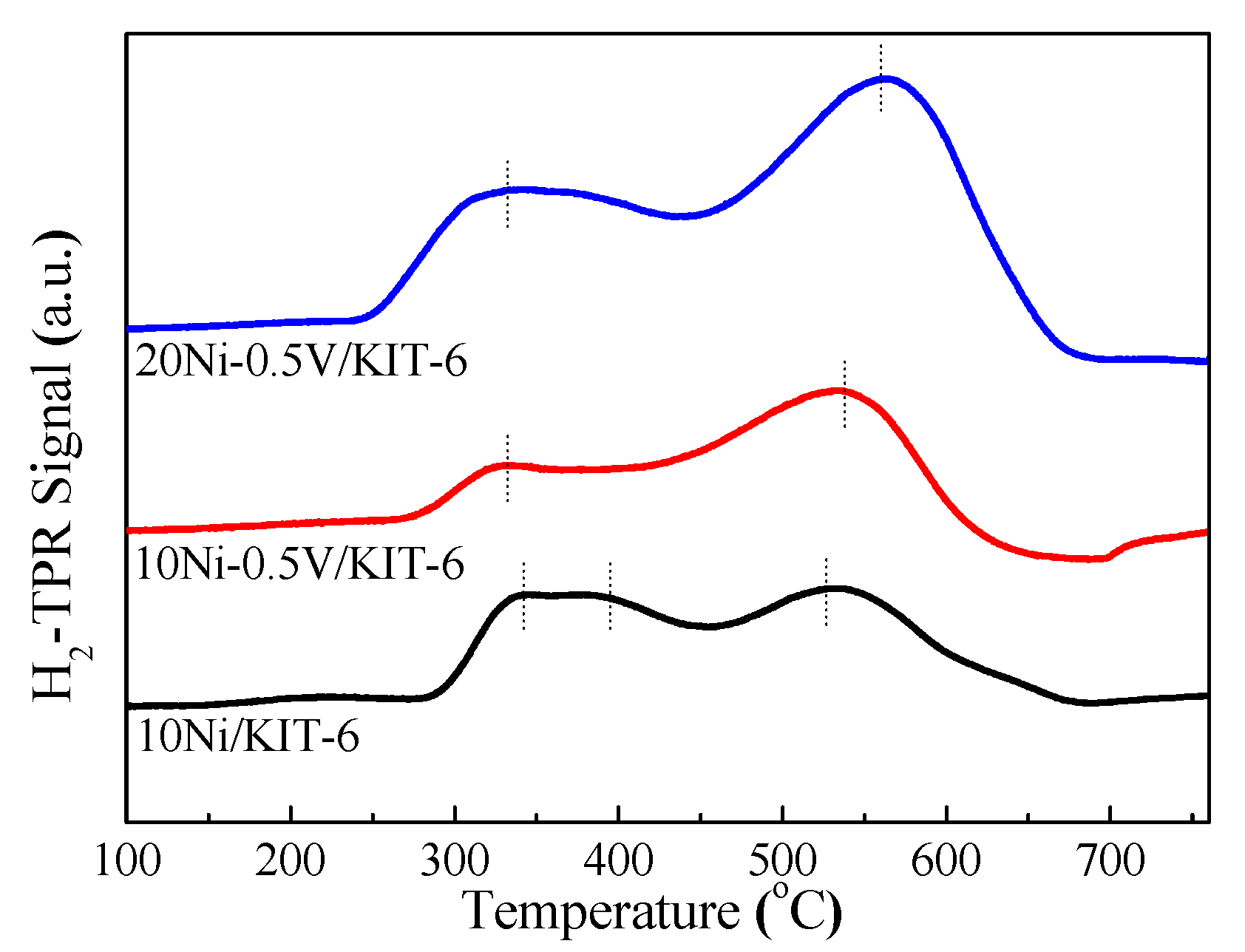
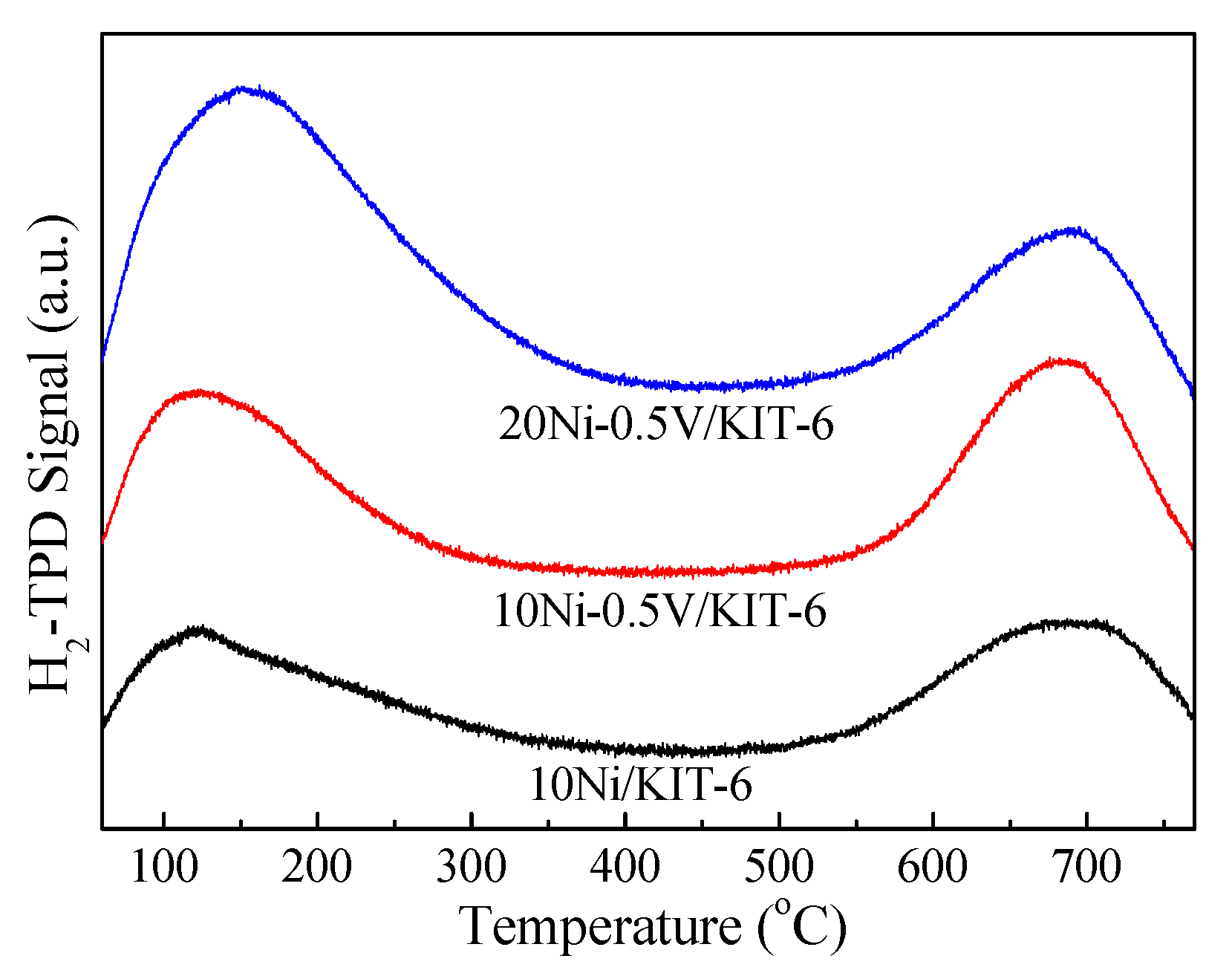
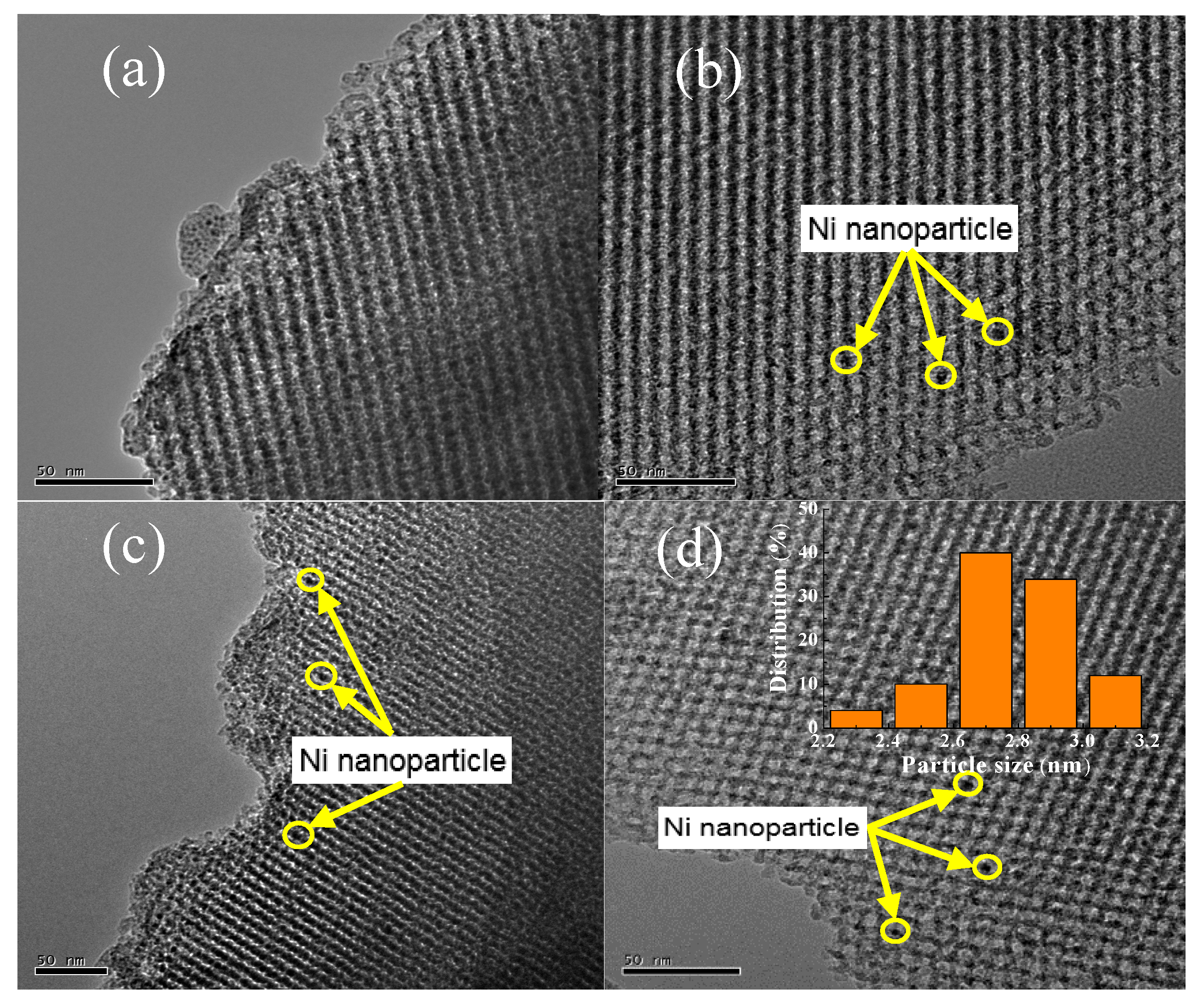
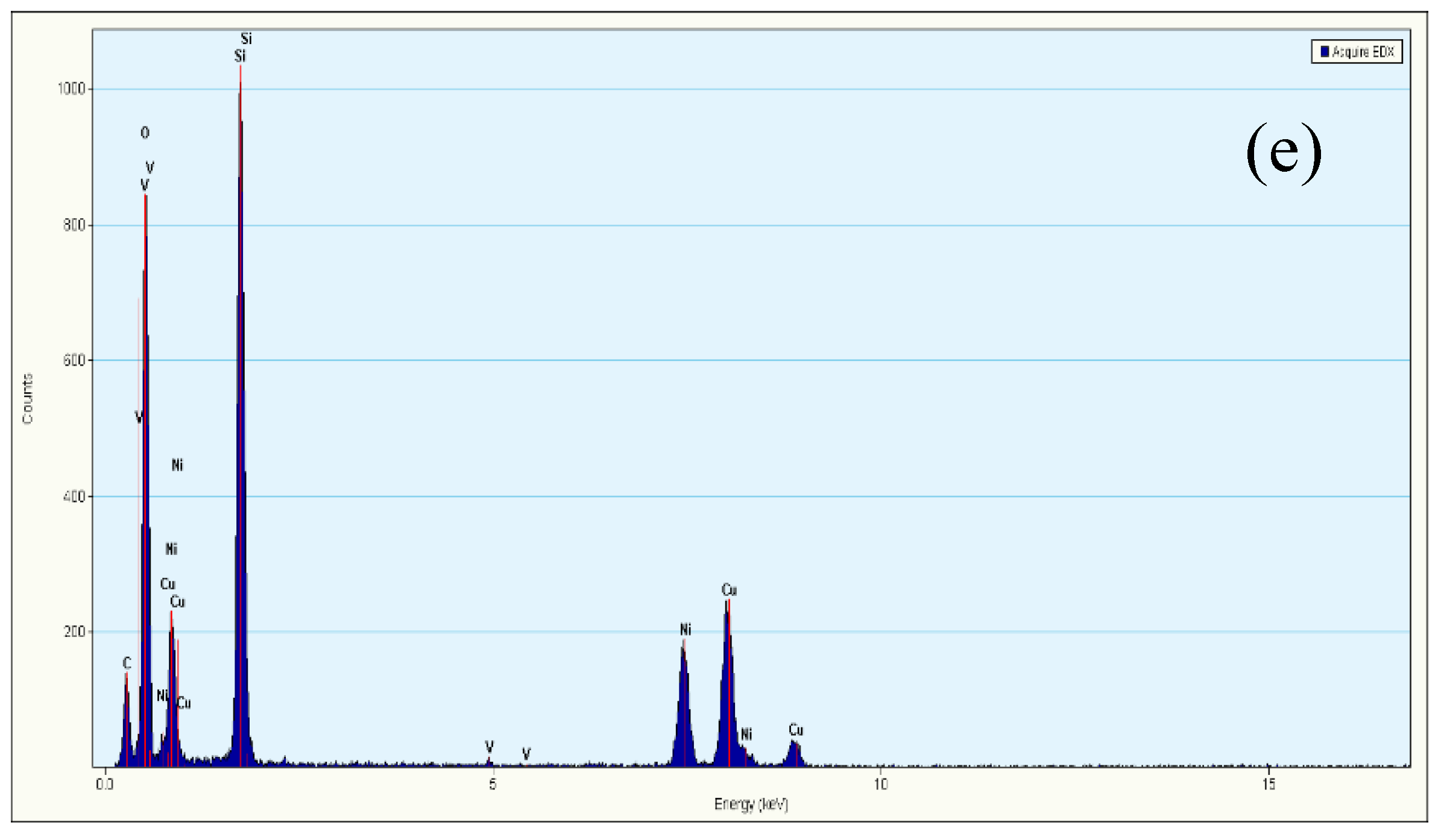


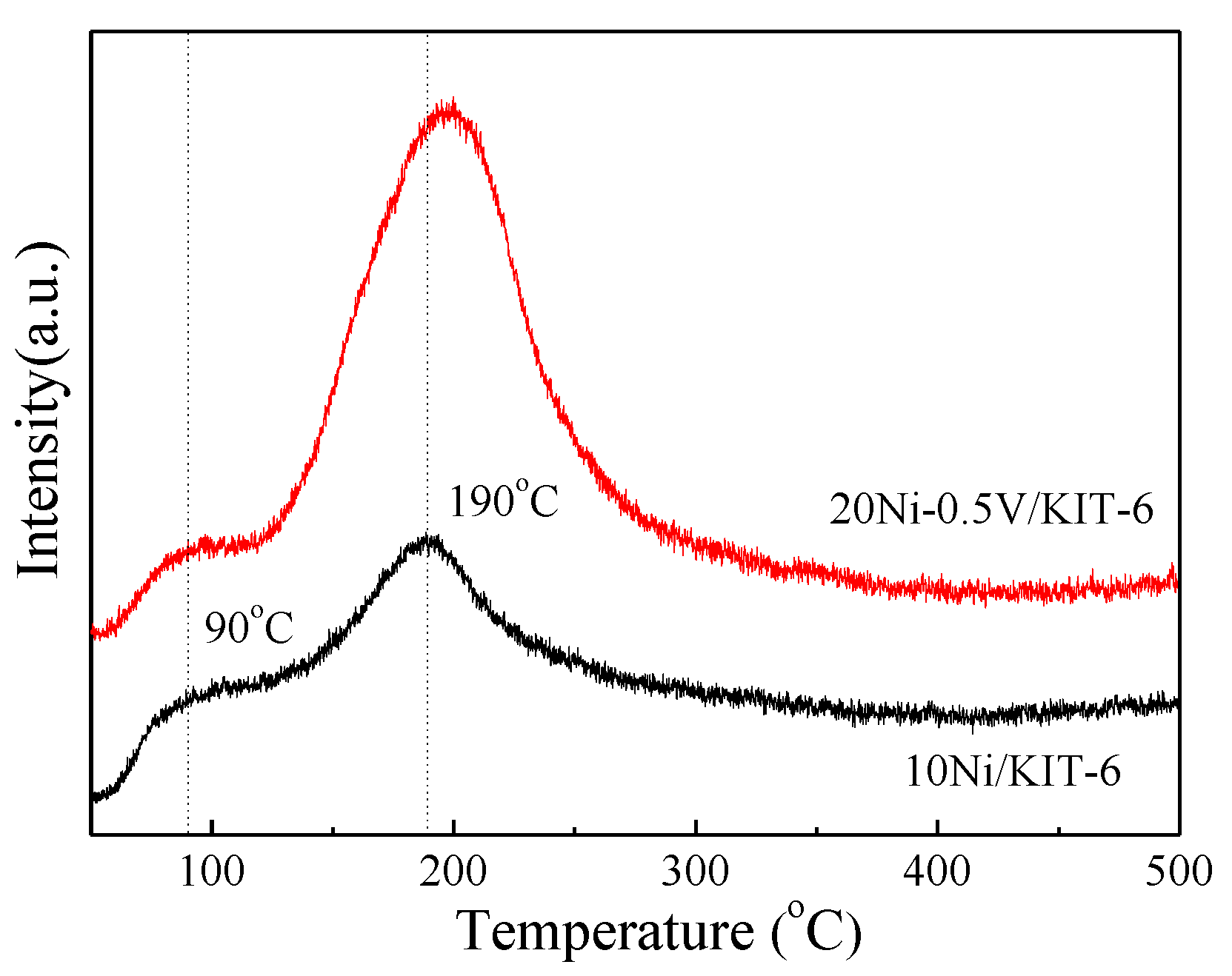
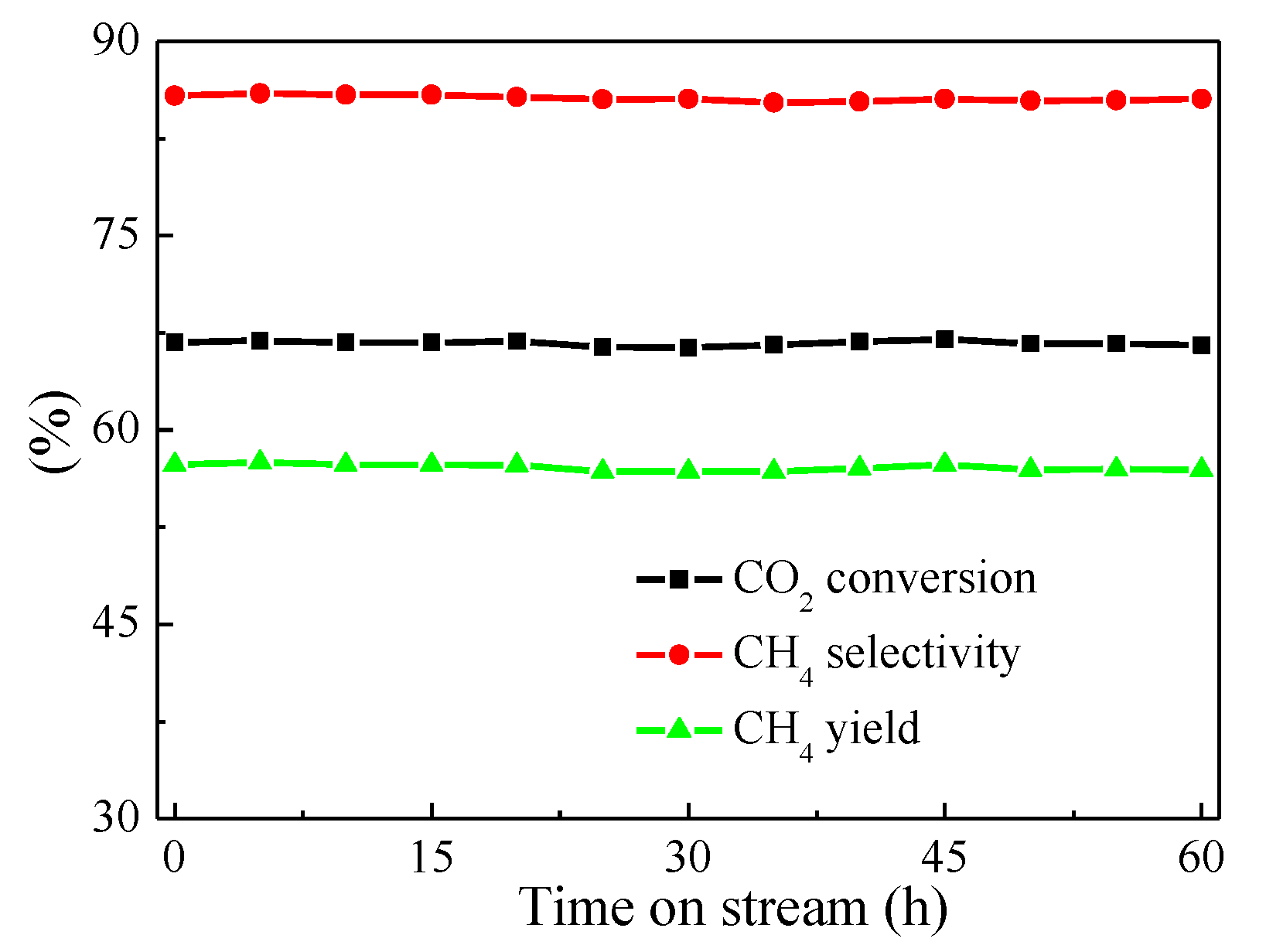
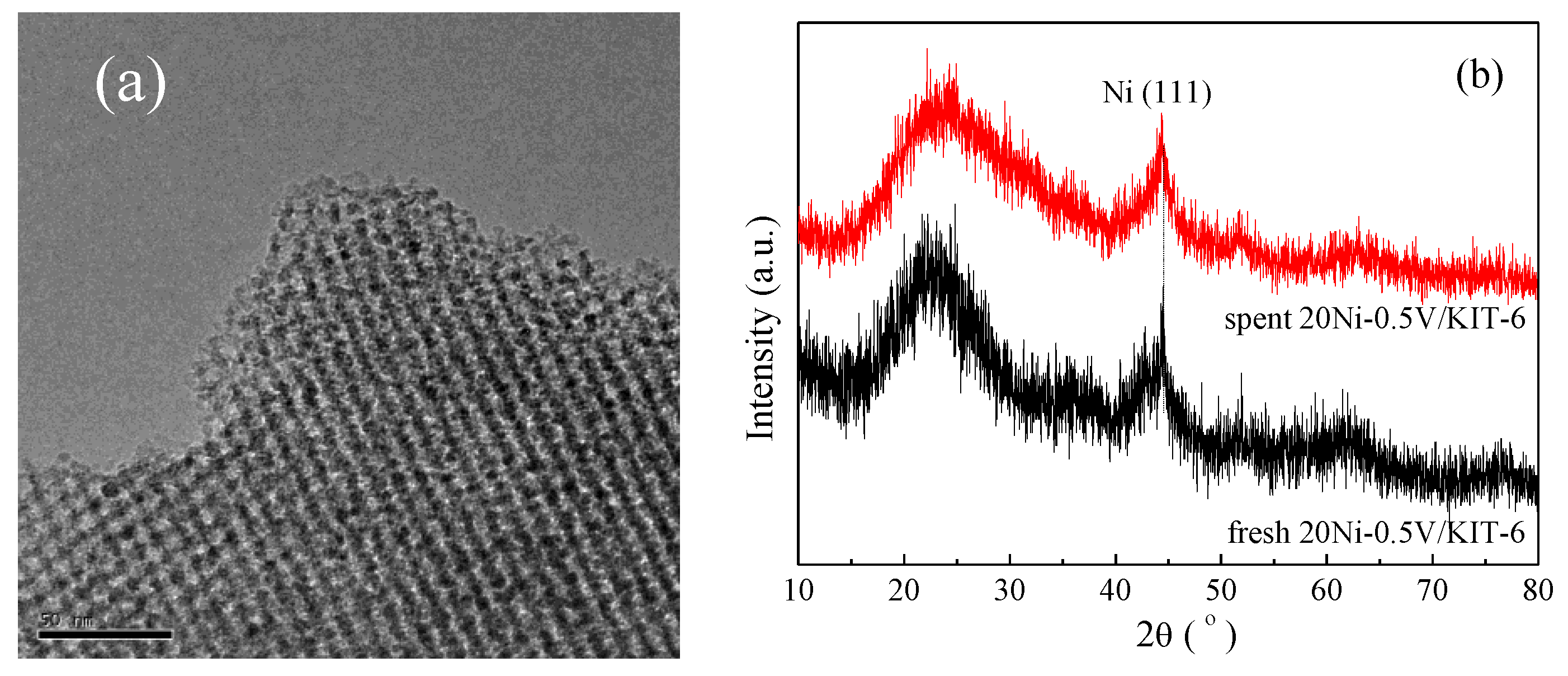
| Catalyst | Ni Particles Size (nm) | H2 Uptake (μmol/g) | D (%) b | Mass Loss (%) c |
|---|---|---|---|---|
| dNi a | ||||
| 10Ni/KIT-6 | 2.4 | 106.0 | 15.8 | - |
| 10Ni-0.5V/KIT-6 | 2.5 | 157.0 | 23.4 | - |
| 20Ni-0.5V/KIT-6 | 2.7 | 168.5 | 25.1 | - |
| spent 20Ni-0.5V/KIT-6 | 2.9 | - | - | 1.2 |
| Catalyst | Ni/NiO Content (wt.%) | Topt (°C) | CO2 Conversion (%) | CH4 Selectivity (%) | WHSV (ml g−1 h−1) | Stability (h) | Ref. |
|---|---|---|---|---|---|---|---|
| Ni-1MgO/SiO2 | 10 a | 400 | <75 | <100 | 15,000 | 10 | [44] |
| 14Ni7CeUSY | 14 a | 400 | 68.3 | 95.1 | - | - | [45] |
| 15Ni/SBA-15 | 15 | 450 | ~70 | <95 | 86,000 | - | [30] |
| 2Ce-20Ni/Al2O3 | 20 a | 350 | 72.7 | 100 | 18,000 | 10 | [46] |
| Ni-20Ce/MCM-41 | 20 a | 380 | 85.6 | 99.8 | 9000 | 30 | [47] |
| 25Ni-Al2O3 | 25 a | 350 | 74 | 99 | 9000 | 10 | [48] |
| 10Co/Al2O3 | 10 a | 400 | 77.8 | 96.5 | 3600 | - | [10] |
| 0.5Ru/Na-TiO2 | 0.5 a | 450 | ~60 | ~90 | 90,000 | - | [15] |
| 10Ni-0.5V/KIT-6 | 10 b | 400 | 82.0 | 100 | 96,000 | - | This work |
| 20Ni-0.5V/KIT-6 | 20 b | 350 | 87.2 | 100 | 96,000 | 60 | This work |
© 2020 by the authors. Licensee MDPI, Basel, Switzerland. This article is an open access article distributed under the terms and conditions of the Creative Commons Attribution (CC BY) license (http://creativecommons.org/licenses/by/4.0/).
Share and Cite
Cao, H.; Wang, W.; Cui, T.; Wang, H.; Zhu, G.; Ren, X. Enhancing CO2 Hydrogenation to Methane by Ni-Based Catalyst with V Species Using 3D-mesoporous KIT-6 as Support. Energies 2020, 13, 2235. https://doi.org/10.3390/en13092235
Cao H, Wang W, Cui T, Wang H, Zhu G, Ren X. Enhancing CO2 Hydrogenation to Methane by Ni-Based Catalyst with V Species Using 3D-mesoporous KIT-6 as Support. Energies. 2020; 13(9):2235. https://doi.org/10.3390/en13092235
Chicago/Turabian StyleCao, Hongxia, Wenyuan Wang, Tianlei Cui, Hongyan Wang, Guang Zhu, and Xiangkun Ren. 2020. "Enhancing CO2 Hydrogenation to Methane by Ni-Based Catalyst with V Species Using 3D-mesoporous KIT-6 as Support" Energies 13, no. 9: 2235. https://doi.org/10.3390/en13092235
APA StyleCao, H., Wang, W., Cui, T., Wang, H., Zhu, G., & Ren, X. (2020). Enhancing CO2 Hydrogenation to Methane by Ni-Based Catalyst with V Species Using 3D-mesoporous KIT-6 as Support. Energies, 13(9), 2235. https://doi.org/10.3390/en13092235





